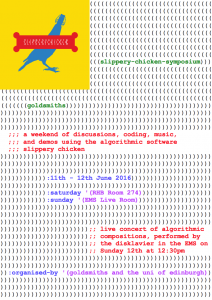
Why
The title of my piece for the slippery chicken Symposium arose after attending a lecture by the composer Christopher Fox on musical memory. One of the points he mentioned was that when we listen to music we tend to have in mind the thing we are currently listening to and the thing we listened to just before that. Every time we hear something that we recognise it is like returning to the (a) chorus, therefore it is possible to say that all music is essentially in rondo form.
How
At the heart of this piece is a rhythm chain, or more specifically, two rhythm chains which give me four lines of counterpoint. Using the add-voice method I then double the number of voices to eight and use the data to generate two separate slippery chicken objects. These are spliced together using my copy-bars-sc2sc method. (Follow the link and you can have it for yourself.)
The rondo part of the piece comes from a third slippery chicken object which contains hand coded rthm-seqs. I substitute these for the sticking points of the rhythm chain using a loop that analyses time signatures bar-by-bar and copy-bars-sc2sc. When the time signature is ‘(3 8) the method does its thing. (The time signature is only ever ‘(3 8) during the sticking points because these are defined as repeated quavers (‘e) in multiples of 3. The rhythm chain itself tends to make bars of ‘(2 4) and ‘(3 4).)
The pitch data is generated from harmonic sequences. Most by harm-list. The ordering of the set-map is determined by L-system rules.
Tempo changes are dependent on the sl-c object and there are brief rallentandi between these sections to make the piece sound more natural. This is further aided by my sc-midi-groove method (NB this is not yet available to the public).
Afters
It is very easy to create interesting material within sl-c but it is much harder to combine several different sections together within the same call to make-slippery-chicken. My copy-bars-sc2sc method makes life a lot easier in this regard and I plan to use it a lot more. At the conference, I presented work I had made using the method and have made it available on my website for anyone else to use. http://vitruviandan.wordpress.com/code
Midi-file of the piece: rondo-del-computer


